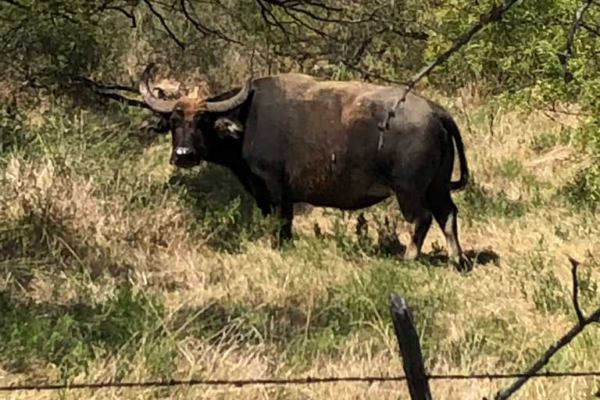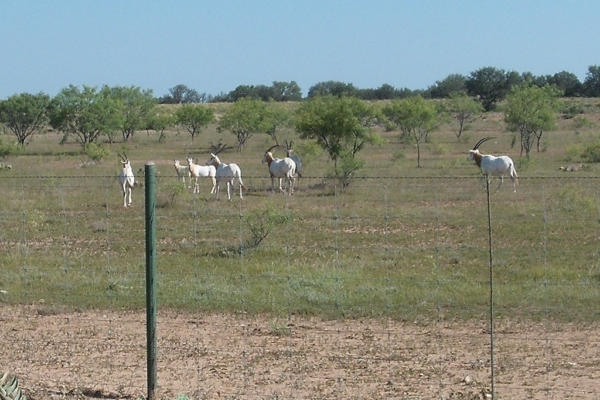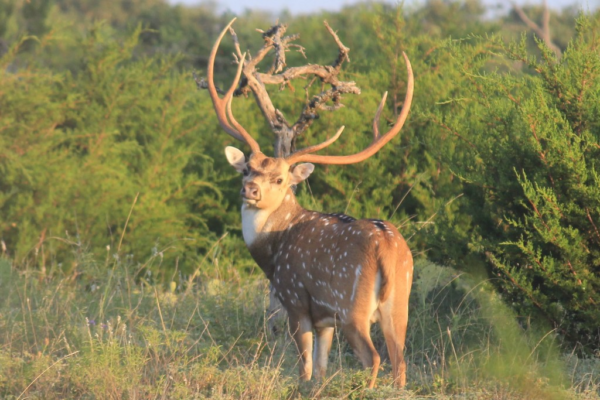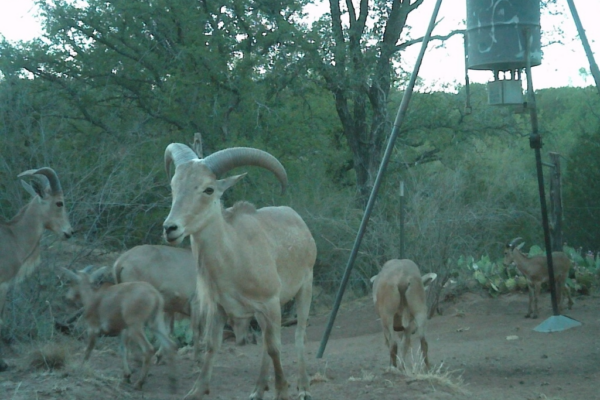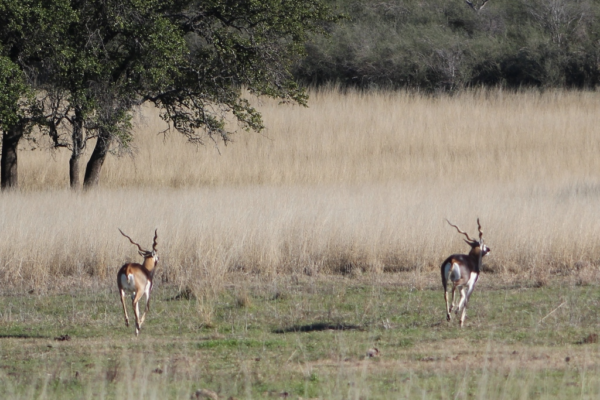Exotics For The Taking
By Judy Jurek
The early morning was clear and cool, but no wind. While sitting in a deer stand 100 yards from the Guadalupe River outside Bergheim, I heard something coming through the rocks. Thunk, thunk, thunk. It sounded big and heavy. Was Sasquatch headed my way?
Suddenly, through dense cedars I saw a patch of tan. Although it sounded like a buffalo hammering across the rocks the color was too light. I was scared! Then it appeared: a large animal with big horns sweeping back towards its massive shoulders. Long hair hung down from its throat and the backs of its front legs.
I had never seen such a creature! What was it? Clearly on a mission, it quickly disappeared toward the river. At camp, another hunter on the opposite end of the ranch had seen it, too. No one believed us, even after drawing a picture of it. Everyone said we’d seen a “Spanish goat.” Nope.
Months later I spied the beast in an outdoor magazine. It was an aoudad. I called the other witness to say we weren’t crazy after all! That incident occurred in 1978, but I recall it like yesterday. It was my first introduction to Hill Country exotics. That aoudad was one of the largest I’ve seen to this day.
Why didn’t I shoot it? First, I had no idea what it was. Second, I didn’t know exotic animals were legal to shoot year-round. Third, at the time I was unaware exotics were escaping from their high fence confines due to such things as flash floods knocking down fencing.
Back then, Mountain Home’s famous Y.O. Ranch was known for its vast array of exotics, but few other ranches were stocking them. However, some exotics quickly became popular mainly because they were legal to hunt all year. Due to the aforementioned flash floods, gates accidentally left open, fences damaged from fallen trees, wildfires and other things, an array of exotic species now range free across the Hill Country.
In a mid-July outside Menard, Ray Johns and his wife Faye were filling feeders on their year-round deer lease. “We rounded a bend and there stood a white-spotted deer,” he said. “It took us by total surprise. At first, we thought it was a really big whitetail fawn, but realized it was an axis as it ran off. The only weapon we had was a .22 for rattlesnakes.”
“We’d hunted that ranch two years,” Ray continued. “No one had ever seen an axis deer. The ranch manager said there were some and we could kill one if encountered. We hunted there four more years and killed one axis doe. That experience taught us to always ride around with a big gun, just in case we see a legal exotic!”
Danielle Ashton also had an axis encounter. “We recently moved to 50 acres at Vanderpool,” she said. “We weren’t surprised to see whitetails and feral hogs at a feeder near the house, but (we) got excited when axis deer appeared. Now, we’ve seen other deer, but are unsure what they are. Some are light-colored, others chocolate, some spotted, but don’t look quite like axis. We’re having fun watching for whatever.”
Danielle noted their freezer is currently full of whitetail and pork, but once it’s depleted, they plan to fill it with visiting exotics. Game cameras will hopefully help identify various animals crossing their property. “Neighbors have said there are aoudad around with exotic sheep and wild goats,” she said. “With all the exotics, our kids will seriously get into hunting more than whitetail and hogs.”
Exotic animals are appealing because they can be hunted all year long. You must have a hunting license, with permission to hunt if you don’t own the land. Today, many species range freely across the state, with the Hill Country clearly hosting the biggest variety. You never know what you will see.
I live on the northeastern edge of the Hill Country in Mills County. I was unable to get a shot at a trophy axis buck I saw one time. A tagged sika doe and buck were captured on my game cam and sighted in the pasture several times. Both animals escaped a nearby high fenced ranch when a gate was left open. Game cameras often reveal animals never seen by anyone.
A Brown County rancher has seen aoudad several times, and other ranchers living deeper into the Hill Country see all manner of exotic deer on occasion, A few years ago, a hunter on the Colorado River shot a bull elk that had wandered onto his property from somewhere.
It’s commonplace to see a variety of exotic beasts behind high fencing. Zebras are popular eye-catchers, as are ostriches and rheas. European red deer and elk are familiar sights. Several species of antelope, goats, sheep, and other species too numerous to name exist in the Hill Country. I’ve seen wildebeest from far distances.
As a hunter, I’ve learned to expect the unexpected, especially while hunting low fence property or land bordering a waterway. Should an exotic appear, it’s yours for the taking if the landowner allows it. Know in advance what you can shoot before pulling the trigger. Your hunting lease agreement should state if taking an exotic is permissible or costs extra.
If you’re seeking a unique hunting experience, Hill Country exotics could be the answer. Do you desire an unusual wall hanger, full body mount, or a distinctive rug or jacket? Do you want a trophy animal or just meat for the table? Your pocketbook may determine your choice, as some species are pricey, while others are quite affordable.
If you’re booking a rifle hunt, ask what caliber is best for your selection. Large exotics such as red stag or nilgai have dense muscles with thick bone, while a blackbuck antelope has a smaller target area with easier bullet penetration. Like native Texas species, exotics have sharp eyes, keen hearing, and a pronounced sense of smell, with some being much wilder than others.
If you’re not a hunter, do you yearn to see exotics elsewhere than in a zoo setting? Many ranches offer wildlife observation packages while enjoying their amenities without killing anything. It’s a great chance for photographers and others to experience exotics, minus traveling halfway around the world. Birdwatchers, too, are often eager to see animals supplementing feathered fliers.
Where do you look for information to hunt exotics, or perhaps to simply enjoy an adventure with them? The tell-all internet offers most everything. Check print publications. Ask friends and fellow hunters for recommendations. Check local feed stores for referrals, or chambers of commerce for area listings. Watch for ranch signage when exploring the countryside.
Riding along Texas highways and byways can offer exotic sightings costing only fuel and time. Keep your eyes open! Wild animals, including whitetails and feral hogs, often stand statue-still, believing you cannot see them. Once you stop, however, they usually vanish quickly.


